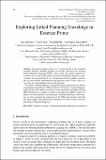Files in this item
Exploring lifted planning encodings in Essence Prime
Item metadata
| dc.contributor.author | Espasa, Joan | |
| dc.contributor.author | Coll, Jordi | |
| dc.contributor.author | Miguel, Ian | |
| dc.contributor.author | Villaret, Mateu | |
| dc.contributor.editor | Villaret, Mateu | |
| dc.contributor.editor | Alsinet, Teresa | |
| dc.contributor.editor | Fernández, Cèsar | |
| dc.contributor.editor | Valls, Aïda | |
| dc.date.accessioned | 2021-10-25T16:30:06Z | |
| dc.date.available | 2021-10-25T16:30:06Z | |
| dc.date.issued | 2021-10-14 | |
| dc.identifier | 276418338 | |
| dc.identifier | ec4e07fc-7618-46a5-86af-46c884795730 | |
| dc.identifier | 85117888140 | |
| dc.identifier.citation | Espasa , J , Coll , J , Miguel , I & Villaret , M 2021 , Exploring lifted planning encodings in Essence Prime . in M Villaret , T Alsinet , C Fernández & A Valls (eds) , Artificial Intelligence Research and Development : Proceedings of the 23rd International Conference of the Catalan Association for Artificial Intelligence . Frontiers in Artificial Intelligence and Applications , vol. 339 , IOS Press , pp. 66-75 , 23rd International Conference of the Catalan Association for Artificial Intelligence , 20/10/21 . https://doi.org/10.3233/faia210117 | en |
| dc.identifier.citation | conference | en |
| dc.identifier.isbn | 9781643682105 | |
| dc.identifier.isbn | 9781643682112 | |
| dc.identifier.issn | 0922-6389 | |
| dc.identifier.other | Jisc: 0998b0d4e14c4ae69a61c47376f5c75d | |
| dc.identifier.other | ORCID: /0000-0002-6930-2686/work/102330416 | |
| dc.identifier.other | ORCID: /0000-0002-9021-3047/work/165297375 | |
| dc.identifier.uri | https://hdl.handle.net/10023/24191 | |
| dc.description | This work is supported by UK EPSRC EP/P015638/1 and EP/V027182/1, by the MICINN/FEDER, UE (RTI2018-095609-B-I00), by the French Agence Nationale de la Recherche, reference ANR-19-CHIA-0013-01, and by Archimedes institute, Aix-Marseille University. | en |
| dc.description.abstract | State-space planning is the de-facto search method of the automated planning community. Planning problems are typically expressed in the Planning Domain Definition Language (PDDL), where action and variable templates describe the sets of actions and variables that occur in the problem. Typically, a planner begins by generating the full set of instantiations of these templates, which in turn are used to derive useful heuristics that guide the search. Thanks to this success, there has been limited research in other directions. We explore a different approach, keeping the compact representation by directly reformulating the problem in PDDL into ESSENCE PRIME, a Constraint Programming language with support for distinct solving technologies including SAT and SMT. In particular, we explore two different encodings from PDDL to ESSENCE PRIME, how they represent action parameters, and their performance. The encodings are able to maintain the compactness of the PDDL representation, and while they differ slightly, they perform quite differently on various instances from the International Planning Competition. | |
| dc.format.extent | 231208 | |
| dc.language.iso | eng | |
| dc.publisher | IOS Press | |
| dc.relation.ispartof | Artificial Intelligence Research and Development | en |
| dc.relation.ispartofseries | Frontiers in Artificial Intelligence and Applications | en |
| dc.subject | Reformulation | en |
| dc.subject | Modelling | en |
| dc.subject | Automated Planning | en |
| dc.subject | Constraint Programming | en |
| dc.subject | QA75 Electronic computers. Computer science | en |
| dc.subject | NDAS | en |
| dc.subject.lcc | QA75 | en |
| dc.title | Exploring lifted planning encodings in Essence Prime | en |
| dc.type | Conference item | en |
| dc.contributor.sponsor | EPSRC | en |
| dc.contributor.institution | University of St Andrews. School of Computer Science | en |
| dc.contributor.institution | University of St Andrews. Centre for Interdisciplinary Research in Computational Algebra | en |
| dc.identifier.doi | 10.3233/faia210117 | |
| dc.identifier.grantnumber | EP/V027182/1 | en |
This item appears in the following Collection(s)
Items in the St Andrews Research Repository are protected by copyright, with all rights reserved, unless otherwise indicated.

